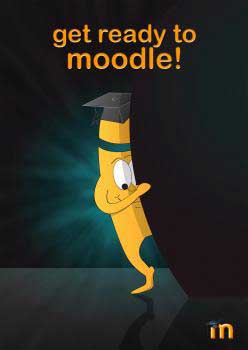You've seen the teaser advertisements around campus for months now – Moodle is most definitely coming. But what is Moodle, why is it on the way and how can we make the most of it?
The Moodle transition is the final stage of a Learning Management System (LMS) migration being undertaken by the University's Curriculum Re-Development Centre (CRDC). It's a massive project that will see the U of L replace the Blackboard/WebCT environment it has been operating in since 1999.
"We're very excited about the move to Moodle," says David Hinger, director of the CRDC. "Moodle is a very powerful tool designed to do many of the things you'd want to do in a face-to-face classroom in an online environment. It really takes advantage of the blended learning theory of education as it allows instructors to put delivery of their content within Moodle, so that they can really take advantage of face-to-face time in class."

The move to Moodle was precipitated by changes within the University's previous LMS. The U of L had been using WebCT since 1999, but in 2005, Blackboard Inc. took over the company and has since ceased providing updates to the WebCT product. The University therefore was forced to look at moving to a new LMS, whether it was to a Blackboard Learn LMS or some other product. A faculty steering committee was struck and Moodle emerged as a clear winner.
Hinger describes an LMS as, "an extension of your face-to-face course. It's a simple way to provide resources and activities, and to have an online presence for your teaching and learning needs."
The reasons the U of L decided to move to Moodle are many, including its design as a constructivist pedagogical model as opposed to Blackboard's content management system approach.
"Moodle is very much built the way educators sit down and design their courses," says Hinger. "It's very simple and intuitive, with a lot less clicking then what you'd do in Blackboard."
The steering committee also found that Moodle was the choice of incoming students, as more than 80 per cent of students had been exposed to a Moodle learning environment in high school. Add in the fact that it is an open source program that lends itself to customizable features, and Moodle seems like the perfect fit for the institution's teaching and learning needs.
"Being an open source program, if there are features that aren't there, we can build them," says Hinger. "If we identify unique needs for our faculty, we can build things within the Moodle environment to do what they need it to do."
The move to Moodle has already begun, with two courses used in the Fall 2010 Semester as part of a pilot program. Currently, 50 courses have been constructed in Moodle, utilizing the University's testing centre and including every manner of course, from art history to management. Feedback from instructors has been positive.
"Those who have had a chance to work with it so far have found it very user-friendly," says Hinger. "But we aren't going to throw instructors to the wolves, we're very committed to providing whatever support they need to use this product. A lot of instructors have looked at this as an opportunity to redesign what they are doing in an online environment and finding it a very valuable exercise. We'll assist them any way we can."
The CRDC will continue to support Blackboard/WebCT through the 2010-2011 academic year, with full implementation of Moodle scheduled for Fall 2011 and the 2011-2012 academic year.
To learn more about Moodle and the LMS migration process, go to the CRDC website at www.uleth.ca/crdc
GET THE FACTS
• The CRDC will be offering workshops to assist instructors with Moodle. As well, an online pool of resources is currently being created.
• The U of L is one of the first in Canada to move to this newest version of Moodle 2.0, which was just fully released in November 2010.
• The U of L previously had 640 courses (70 per cent) operating in Blackboard/WebCT, with over 6,000 students utilizing the program.
• Other features of Moodle include the ability to embed videos, moderate virtual chats and forums and conduct online exams.
